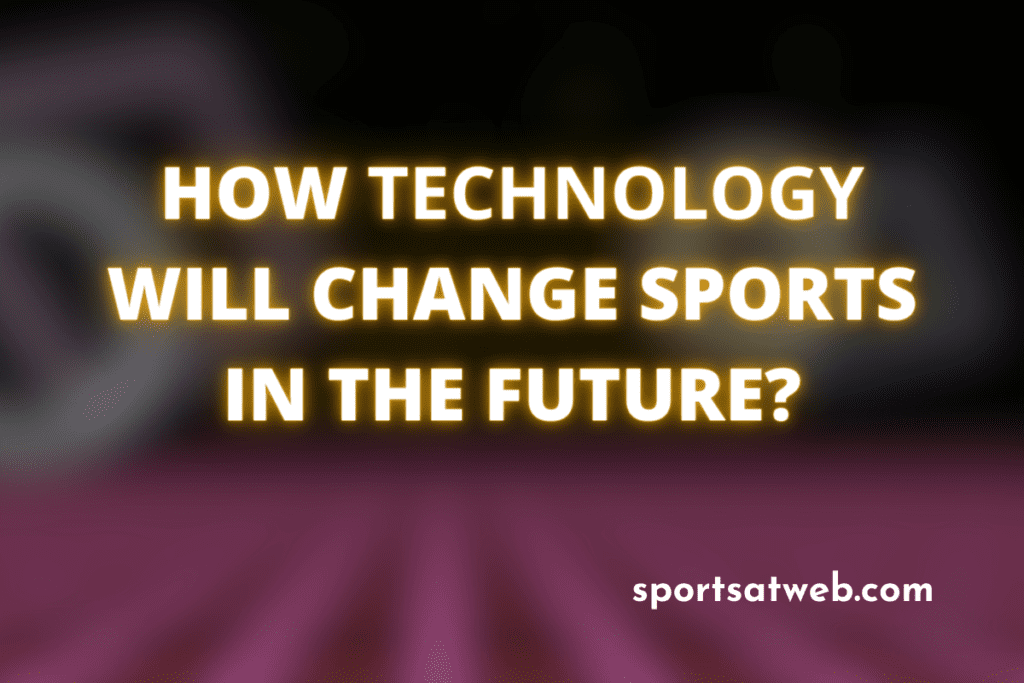In recent years, technology has profoundly impacted various aspects of human life, including the world of sports. Technology has become an indispensable ally, from enhancing performance and training methods to refining officiating and fan experiences. Its impact can be witnessed across different sports, empowering athletes, coaches, and fans alike. How Does Technology Help Sports? By harnessing cutting-edge innovations such as wearable devices, advanced analytics, virtual reality, and high-speed cameras, technology has opened up new avenues for athletic achievements, improved safety measures, and unparalleled engagement.
These are the Few Points on How Technology Helps Sports

Performance Enhancement
Training and Conditioning
Cutting-edge technologies have revolutionized the way athletes train and condition their bodies. Wearable devices, such as fitness trackers and smartwatches, provide real-time feedback on vital metrics like heart rate, distance covered, and calories burned. This data enables athletes to monitor their progress, set goals, and optimize their training regimes for better performance.
Performance Analysis
Technological advancements have greatly improved the analysis of athletic performance. High-speed cameras, motion sensors, and biomechanical analysis tools allow coaches and athletes to dissect movements with precision. By identifying flaws in technique and form, athletes can make targeted improvements and optimize their efficiency, leading to enhanced performance on the field.
Injury Reduction and Prevention
For athletes, sports-related injuries are a major source of worry. However, injury prevention and recovery have benefited greatly from technology. MRI and CT scans are examples of advanced imaging methods that help with early diagnosis and fast treatment. In order to ensure a safe and effective return to play, wearable sensors and monitoring devices have also been developed to aid in tracking an athlete’s recuperation process.
Game Performance and Analysis
Video Assistant Referee (VAR)
The use of VAR has changed how sports referees make judgment calls. Using video technology, referees can study and evaluate crucial events during a game, such as goals, penalties, or offside calls can study and evaluate crucial events during a game, like goals, penalties, or offside calls, by using video technology. VAR has boosted accuracy and fairness in sports like football, rugby, and cricket sports like football, rugby, and cricket, VAR has boosted accuracy and fairness while decreasing human error and controversy.
Hawk-Eye Technology
In addition to cricket, football, and even snooker, Hawk-Eye, addition to cricket, football, and even snooker, Hawk-Eye, which was initially created for tennis, is now often utilized in many other sports. When it comes to goal-line rulings and line calls, as well as tracking player movement throughout the play, this computer vision system follows the ball’s trajectory with exceptional accuracy.
Real-Time Data and Analytics
The means by which sports teams examine and interpret information have been changed by technology. Real-time knowledge of player performance, team plans, and opponent analysis is provided through advanced analytics solutions. With the use of data, coaches may make quick tactical changes and obtain an advantage in their particular sports.
Fan Engagement and Experience
Virtual Reality (VR) and Augmented Reality (AR)
Virtual and augmented reality technologies have significantly enhanced the fan experience. VR allows fans to immerse themselves in a virtual stadium environment, providing a unique perspective of the game. AR, on the other hand, overlays digital information onto the real world, offering interactive experiences like live stats and player information through mobile apps.
Social Media and Digital Platforms
Through social media platforms and digital channels, sports fans now have unparalleled access to their favorite teams and players. Fans may interact with players directly, follow their preferred teams, and access exclusive behind-the-scenes material. This link strengthens fan loyalty and fosters a feeling of community while extending sports’ influence throughout the globe.
Enhanced Broadcasting and Viewing Experience
Technological advancements have transformed the way fans consume sports content. High-definition broadcasts, multiple camera angles, slow-motion replays, and interactive graphics enhance the viewing experience. Additionally, the integration of advanced data and statistics during live broadcasts allows fans to delve deeper into the game and gain insights like never before.

Sports Equipment and Gear
Modern Sports Equipment
Sports equipment has experienced a revolution thanks to technology, making it more secure as well as efficient. Tennis racquets, for instance, are created employing cutting-edge materials and technical methods to improve power and control. Similar improvements in accuracy and distance have been made because of advances in golf club technology. Athletes can perform at their peak and push the limits of their sport thanks to such developments.
Protective Gear
In contact sports, the development of advanced protective gear has significantly reduced the risk of injuries. Helmets, pads, and braces are designed using innovative materials that provide better impact absorption and protection. This ensures the safety of athletes and enables them to compete with confidence.
Data Tracking and Performance Metrics
Player Monitoring Programs
Player monitoring systems gather information on athletes’ movements in real-time during games or practices using sensors and GPS technology. This information contains parameters like speed, traveled distance, acceleration, and even heart rate. This data may be used by coaches and trainers to make data-driven choices, improve tactics, and create training plans specifically for each athlete.
Biometric Surveillance
Wearable sensors are used in biometric monitoring to keep track of an athlete’s physiological data, such as oxygen levels, heart rate variability, and sleeping habits. This knowledge aids in preventing overtraining, enhancing performance, and emphasizing rest and recovery by offering insights into an athlete’s general health and recovery.
Sports Broadcasting and Media Coverage
Live Streaming and On-Demand Content
Technological advancements have made it easier than ever for fans to access live sports events and on-demand content. Streaming platforms and mobile apps allow fans to watch games from anywhere in the world, eliminating geographical barriers and expanding the reach of sports. This accessibility enhances the fan experience and broadens the fan base.
Experiences with Immersive Viewing
Sports broadcasting now offers viewers a level of immersion never before possible thanks to virtual reality (VR) and 360-degree video technology. Fans that participate in this opportunity gain a unique viewpoint and increase their level of involvement with the game. The fan experience becomes more engaging as a result of this innovation’s addition of a new dimension.
Sports Science and Research
Biomechanical Analysis
Advancements in motion capture technology and biomechanical analysis have revolutionized sports science research. By capturing and analyzing movement patterns, scientists can gain valuable insights into technique, efficiency, and injury prevention. This knowledge informs coaching practices, training methodologies, and equipment design.
Analytics and Predictive Modeling in Sports
Large volumes of sports data are analyzed using sophisticated data analytics tools and predictive modeling algorithms to uncover useful information. In order to provide teams and coaches with a competitive edge, this data-driven strategy looks for patterns, trends, and tactics. Even game results may be predicted using predictive models, which can help guide decision-making.
Conclusion
Technology continues to push the boundaries of what is possible in the world of sports. From performance enhancement and injury prevention to fan engagement and data-driven decision-making, the impact of technology on sports is undeniable. As technology evolves further, we can expect even more innovative solutions that will continue to shape and transform the sports industry for the better.













